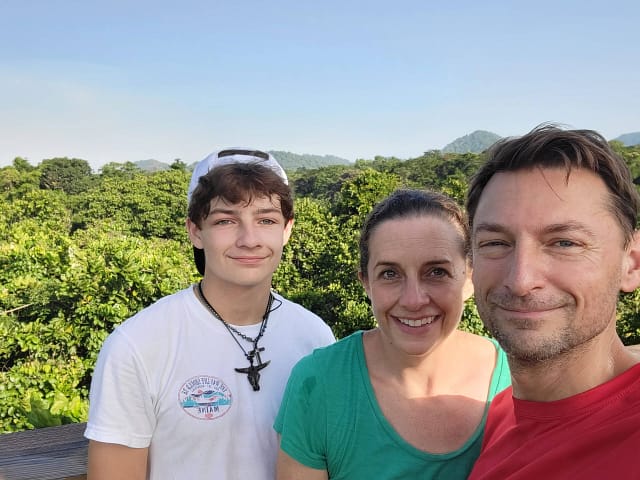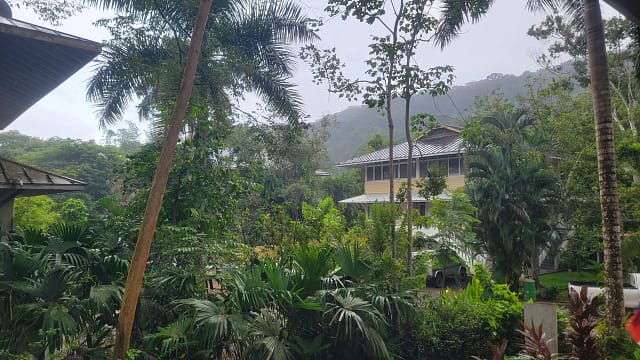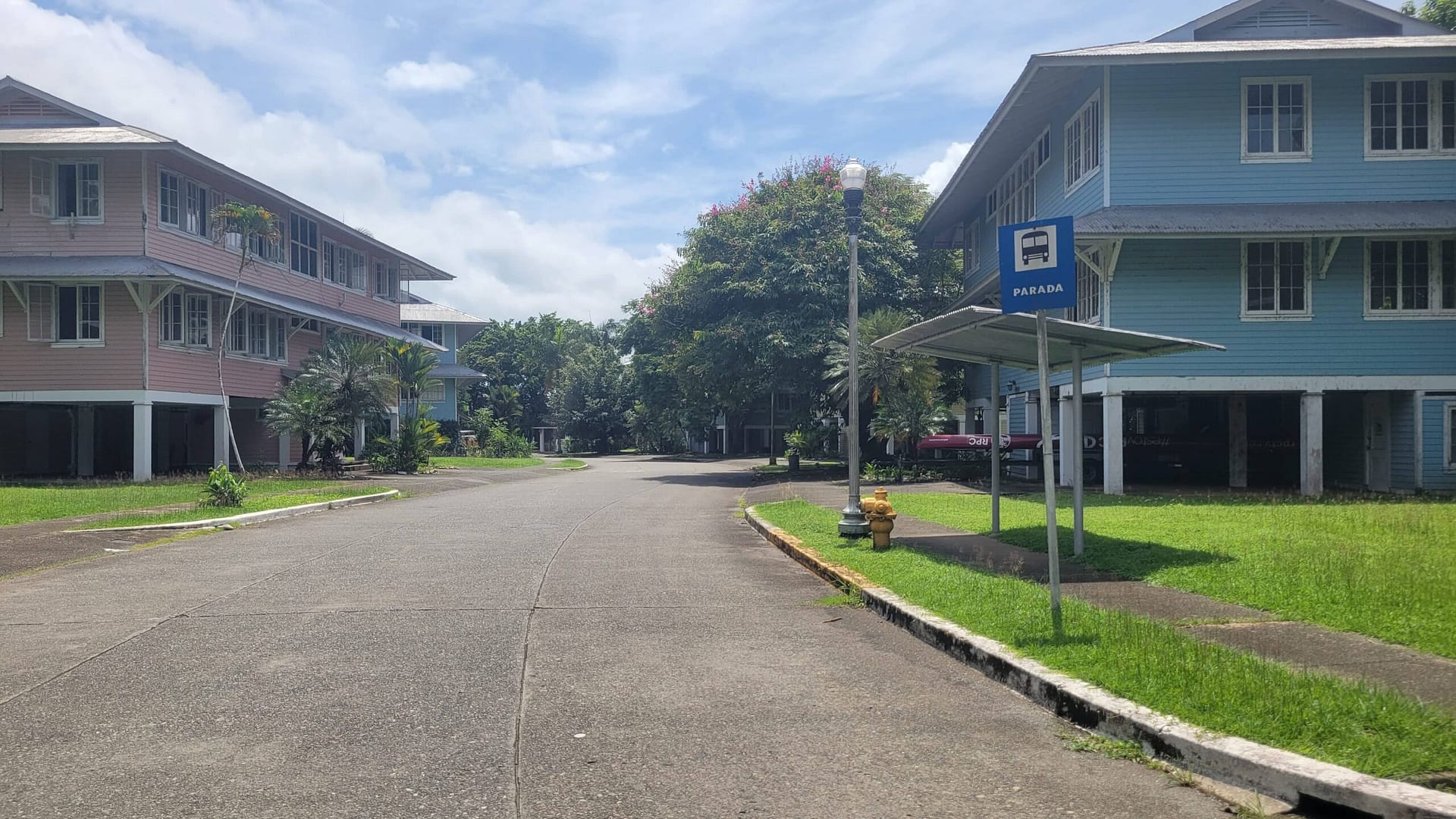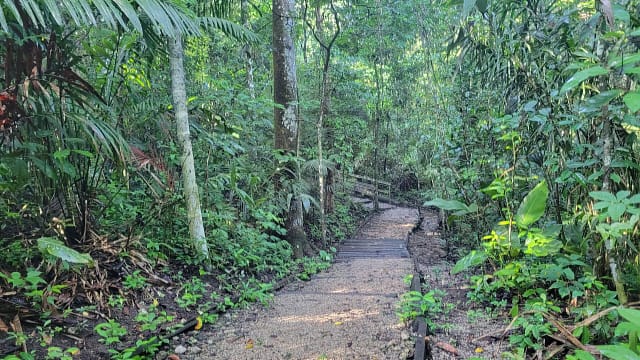After three weeks in Panama we decided to change course by visiting Gamboa. Why? Because it’s roughly the halfway point of the Panama Canal, home to maintenance operations for the canal, and home to a number of “eco” experiences. When planning our trip, we figured we could do a lot of hiking, visit the Rainforest Discovery Center, see the Sloth Sanctuary, and go zip-lining. Little did we know.
Panama Canal is the Star
Gamboa is really all about the Panama Canal. While the Rainforest Discovery Center and pipeline road are well worth the visit (and the cost), the Sloth Sanctuary and “bonus” activities are definitely not.
As you enter town you first see a very old lighthouse from 1914 on the bank of the Chagres River, as well as huge navigational signs on the hillsides for ship pilots. But you really can’t miss is the 1941 ‘Titan’ Floating Crane sitting by “downtown” Gamboa. If you had any doubts at all about the Panama Canal and Gamboa’s importance to canal operations today, they are immediately put to rest.
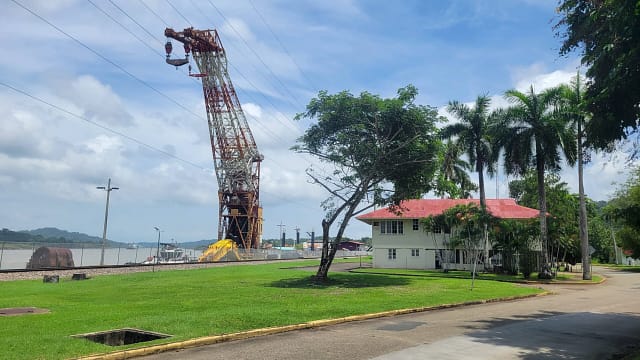
Quaint Hold Homes
When we first arrived at our Airbnb we were struck by how all the homes on the very short street looked similar. Cool we thought. We’ll see the rest of town when we go walking to the Gamboa Store.
Turns out virtually every single home in the entire town, and it’s not much of a town, are based on a French modular design encountered by the US Military in 1903 when they arrived at the canal.
Not only are all the houses based on these French design concepts, but so are virtually all the other buildings in town as well. The designs developed by the French, and improved by the Americans have lots of features specifically suited to the jungle climate here. From large overhangs to protect from sun and rain, to end gables to cool and remove humidity in the attics, and redwood siding to protect against termites.
The homes and buildings of this town continue to adhere to the designs of the early 1900’s with community efforts to preserve and maintain the architectural and aesthetic principles. No government involvement! On the downside, most of the community buildings – like the swimming pool, athletic facilities and sports field – are closed and falling apart in the jungle climate.
The Other Gamboa
So is Gamboa the town that time forgot? On the one hand, it’s trying. On the other hand there is STRI. Not familiar with the acronym? Its the Smithsonian Tropical Research Institute.
The STRI also features prominently in Gamboa. They have multiple more modern buildings, including a brand new research lab. And they have multiple plots of land with greenhouses, geodesic domes, glass boxes, and more for myriad research projects that can only be done in the jungle.
And nearby is Barro Colorado Island, created by the flooding for the canal and which has been home to a wide variety of research projects for more than 100 years.
A large number of the “residents” of Gamboa are actually researchers or employees of other non-profits based out of Gamboa.

Eco Tours in Gamboa
Jungle abounds around Gamboa and there is a lot to do though we had mixed feelings. We hiked pipeline road out to the Panama Rainforest Discovery Center. While hot and sticky this was well worth it, including climbing to the top of the birdwatching tower. We heard howler monkeys, saw a ton of birds, and really enjoyed the humming birds. While a bit expensive we felt great to know the money supported research and keeping the jungle preserved.
On the other hand, you have the “eco” activities arranged by Gamboa Rainforest Reserve. This resort offers eco activities that we found overly sanitized, poorly maintained, and setup for guests to experience a bit of nature without risk of breaking a sweat. We enjoyed the sloth sanctuary but found it irritating that we had to be bused over to it (its on the other side of the resort property and about a 5-7 min walk) and had to take a “tour” from a resort employee who basically read a script through a megaphone.
Monkey Island Tours are another thing that are popular in Gamboa. I’m not sure if they really qualify as “Eco” since what you really have is tons of tourists feeding monkeys and habituating them to humans. However, our tour (from Airbnb Experiences) was well run with a very knowledgeable guide who took time to find and help us see tamarin, capuchin, and howler monkeys, caimans, two-toes sloths, and a Jesus Christ Lizard. So this was well worth the cost. Shop around for price and read reviews – do not book from Gamboa Rainforest Reserve.
The Best Part of Gamboa
There is not a ton to do in Gamboa apart from experiencing the jungle. Late afternoon downpours offering a welcome respite from the heat. Evening walks provided entertainment with a chorus of parakeets that swarm the trees. There is even opportunity to spot the occasional toucan.
We found ourselves forced to slow down and this was perhaps the best thing of Gamboa. I read an entire book while there. We walked every morning and hid from the heat in the afternoon. The best activity from my perspective was multiple family game nights, making great use of Monopoly, Panama Edition (all in Spanish).
